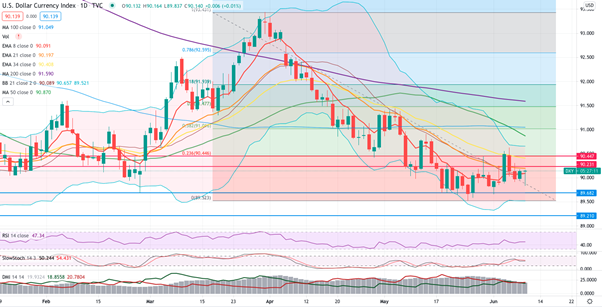It’s a big week for the financial markets with the US consumer price index (CPI) being published on Thursday.
Close to a year has passed since the Fed’s infamous announcement on the average inflation targeting (AIT) regime at the Jackson Hole conference last year, and investors are becoming increasingly nervous about inflation.
The consensus expects a core inflation of 3.4% and a headline inflation of 4.7%. However, a higher print is very likely with fundamentals, such as wage growth and energy prices, moving upwards.
We saw a surprise last month when core inflation jumped to 3.0%, a 0.7% hike from what was expected for April.
Despite the 10-year yield touching 1.7% and the 10-year breakeven reaching 2.54% early in May, recent market movements have been more muted. The 10-year yield broke the support levels at 1.543% and 1.48% on Wednesday, adding weight to an already soft US dollar.
The DXY index, currently at $90.1, is one percentage point away from swing lows at $89.2. Technical indicators support a weak bearish trend to continue with range bound movement between $90.2 and $89.7.
A weak dollar has also supported oil and other commodities.
Oil futures have been trending higher, touching an important resistance level of $70 on Wednesday, bringing the month-to-date price increase to 4.05%. Keep in mind too that energy prices will feed into headline CPI, which is projected to jump to 4.7% in May.
On the other hand, these softer rates and the weaker dollar did not have much of an impact on the equity markets.
The only major index to show some conviction was the Russell 2000, which shed 0.71%. The S&P 500 was near its all-time highs of 4238.04 points but closed 0.18% lower at 4219.54. Nasdaq 100, which should have gotten the most support from the lower rates, was flat, closing at 13,814.94 points.
From a sector perspective, the defensives were leading the way with healthcare up 0.97% and utilities 0.89%, while technology ETF XLK that benefits from lower rates only gained 0.07 percentage points.
After a period of relative calm, the markets are likely to have an emotive reaction to this week’s CPI data.
With a higher-than-expected inflation, we might see a credit market selloff, which should push interest rates higher. The 10-year yield might snap back to resistance near 1.55%, after sliding two standard deviations below from its mean of 1.58% earlier in the week. Higher rates are likely to weigh on equities, in particular the technology-related sectors, while supporting the dollar.
Nevertheless, recent rate movements indicate that investors have accepted the Fed’s narrative about inflation being transitory or are simply waiting for the labor market to recover later this summer. September might bring the first round of clean data on labor market health with extended benefits coming to an end and schools re-opening.
If we combine this week’s CPI announcement with next week’s FOMC meeting, markets and the US dollar are bound to see plenty of movement, all thanks to inflationary pressure and expectations and the US government’s corresponding response. The Fed is expected next week to start laying out its plan to start tapering and eventually increase interest rates, a move that will add to the action likely to happen following today’s announcement.
Note: All information on this page is subject to change. The use of this website constitutes acceptance of our user agreement. Please read our privacy policy and legal disclaimer. Opinions expressed at FXstreet.com are those of the individual authors and do not necessarily represent the opinion of FXstreet.com or its management. Risk Disclosure: Trading foreign exchange on margin carries a high level of risk, and may not be suitable for all investors. The high degree of leverage can work against you as well as for you. Before deciding to invest in foreign exchange you should carefully consider your investment objectives, level of experience, and risk appetite. The possibility exists that you could sustain a loss of some or all of your initial investment and therefore you should not invest money that you cannot afford to lose. You should be aware of all the risks associated with foreign exchange trading, and seek advice from an independent financial advisor if you have any doubts.
Recommended Content
Editors’ Picks
USD/JPY jumps above 156.00 on BoJ's steady policy

USD/JPY has come under intense buying pressure, surging past 156.00 after the Bank of Japan kept the key rate unchanged but tweaked its policy statement. The BoJ maintained its fiscal year 2024 and 2025 inflation forecast, disappointing the Japanese Yen buyers.
AUD/USD consolidates gains above 0.6500 after Australian PPI data

AUD/USD is consolidating gains above 0.6500 in Asian trading on Friday. The pair capitalizes on an annual increase in Australian PPI data. Meanwhile, a softer US Dollar and improving market mood also underpin the Aussie ahead of the US PCE inflation data.
Gold price keeps its range around $2,330, awaits US PCE data

Gold price is consolidating Thursday's rebound early Friday. Gold price jumped after US GDP figures for the first quarter of 2024 missed estimates, increasing speculation that the Fed could lower borrowing costs. Focus shifts to US PCE inflation on Friday.
Stripe looks to bring back crypto payments as stablecoin market cap hits all-time high

Stripe announced on Thursday that it would add support for USDC stablecoin, as the stablecoin market exploded in March, according to reports by Cryptocompare.
US economy: Slower growth with stronger inflation

The US Dollar strengthened, and stocks fell after statistical data from the US. The focus was on the preliminary estimate of GDP for the first quarter. Annualised quarterly growth came in at just 1.6%, down from the 2.5% and 3.4% previously forecast.
